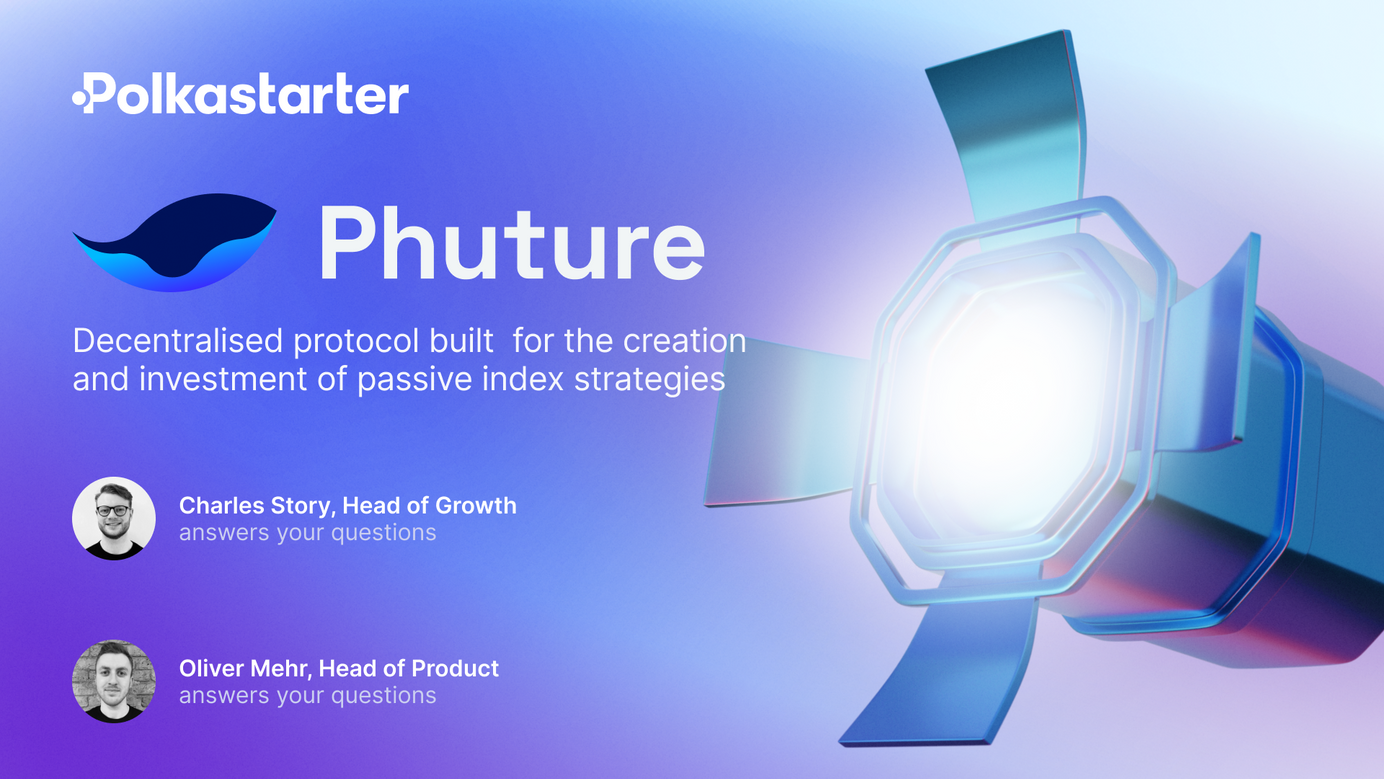
Polkastarter and Phuture AMA Recap
Our AMA Recap with Phuture Co-Founders: Charles Storry, Co-Founder & Head of Growth and Oliver Mehr, Co-Founder & Head of Product
You can see the original AMA conversation in Polkastarter’s Telegram channel here.
Polkastarter
Hi everyone and welcome to another exciting Polkastarter AMA, this time with the co-founders of Phuture, Charles Storry and Oliver Mehr.
Welcome both, and thank you for taking the time today to join us!
Charles Storry
Great to be here!
Oliver Mehr
Thanks for having us!
Polkastarter
Woohoo! Alright, we’ll first have a few questions to Charles and Oliver directly, before we open it up for community questions. Let’s get started!
Charles and Oliver, could you please first introduce yourselves?
Charles Storry
Oliver and I have been in the crypto space since 2016 and have worked together for the past 5 years. Prior to Phuture, we were partners at SVK Crypto, a UK based Venture Firm backed by Block.One - we invested into early stage businesses utilising blockchain technology.
We have invested in an array of different industries from Adtech, to Gaming to VR. We co-invested alongside some great names, such as - Google Ventures, Kliener Perkins, Galaxy Digital, Polychain Capital and Alibaba to name a few.
We helped our portfolio companies integrate blockchain technology into their business. One point to note was that these businesses had traditional users who were not familiar with using blockchain tech. We worked very hard to integrate it in ways that were seamless and that didn't change the UX. A lot of these lessons have found their way into the design of Phuture and why we feel that Phuture will be able to attract not just crypto native users, but also non-crypto natives looking to make their first investment into crypto.
We have raised $1.5M in a recent seed round and we are proud to share that we are supported by some of the most forward-thinking investors in the Web 3 landscape, backed by Ascensive Assets, NGC Ventures, SevenX, Moonrock Capital, Origin Capital, Waterdrip Capital, and D64 Ventures. ✅
Polkastarter
That's awesome — usability and UX is such a key part of building successful and lasting Web3 projects 💪
Can you tell our community a bit more about the vision behind Phuture, and why are you launching it?
Oliver Mehr
For some background:
Index investing is a cornerstone of traditional asset management and the top index providers have accumulated trillion-dollar AUMs. It is estimated that nearly 50% of the value in the U.S. stock market is held by index funds.
With crypto markets developing it is highly probable that asset and strategy allocation will begin to converge with traditional finance. Phuture’s index platform stands to benefit from this influx of capital.
As the token economy expands and becomes more diverse, participants will want products that can provide them with diversified exposure to these different sectors.
Sector specific indices will become the schelling point for benchmarking performance.
We believe that index investing is still such a small part of crypto investing but believe that it will grow commensurate to the traditional markets over time. As the next marginal user enters crypto he/she are not all likely to want to get deep into the weeds of each project. Providing easy to access index products is the key to supporting the growth of crypto into the mainstream.
To make this vision a reality, we are taking a unique approach to building our platform such that it can scalably support a large number of indices simultaneously.
Polkastarter
Thats awesome — building the future of index investing for when the floodgates open!
Polkastarter are big believers that the team and talent behind the project is one of the most important factors for success. 👯♀️👯♀️ Can you tell us more about the team behind Phuture, and how your experience has led you here?
Charles Storry
We are an experienced team with backgrounds from traditional venture and technology development.
I've been active in the crypto ecosystem for the last five years. Partner for UK-based venture firm focused on digital transformation. Main role has been sourcing early-stage venture deals and managing relationships within a number of different industries. Co-invested alongside Google Ventures, Galaxy Digital, Warner Music Group and IDG Capital.
As pointed out in a previous message above, Oliver and I helped our portfolio companies integrate blockchain technology into their business. One point to note was that these businesses had traditional users who were not familiar with using blockchain tech. We worked very hard to integrate it in ways that were seamless and that didn't change the UX.
A lot of these lessons have found their way into the design of Phuture and why we feel that Phuture will be able to attract not just crypto native users, but also non-crypto natives looking to make their first investment into crypto.
Oliver Mehr
I have four years of venture capital experience as a partner and investment analyst focusing on blockchain technology. Successfully executed multiple large venture transactions. Experienced in managing deal analysis from conception to investor committee. Invested alongside Alibaba, Kleiner Perkins and Fidelity.
Polkastarter
Working full time in crypto for 4/5 years — that's like centuries haha
Oliver Mehr
Yeah!
Charles Storry
Certainly feels that way : )
Polkastarter
Hahaha - and a great traditional finance and tech experience to bring to Phuture and Web3🤓
So let's talk about Phuture's competitive advantage. What differs you from other similar projects?
Oliver Mehr
Let me start with this:
Phuture has designed its platform in a unqiue way to our competitors. I define these comps as Index Coop, Powerpool, PieDAO and Indexed. The latter three are all based on balancer smart pools. One thing that those projects have realised is balancer smart pools are in flexible due to being an AMM.
Here are some examples: When you create new balancer smart pool it doesnt have any liquidity, so users cant do one sided deposits because slippage is too high. Therefore, users must bring every asset in the index in order to mint. This is a poor user experience, most people dont own all the assets of an index, that is the reason they are buying. Phuture solves this by tapping into external liquidity, this means that regardless of the size of your index, your execution costs will be roughly the same. Whereas on balancer the depth of the pool heavily dictates how much price impact you experience. This might be fine if you only have a few indices which are all quite deep but on Phuture we are letting anyone create indices which means we will have indices that are not that popular. Regardless, if someone wants to invest in a less popular index it should be the same experience.
The other problem that smart pools have are related to optimisation. In order to push assets to yield optimisers you must remove assets from the AMM, this negatively affects the price impact when minting. If you smart pool is only small you cannot afford to push any assets to yield optimisers. Therefore, these smaller indices dont get additional yield. On Phuture, we aggregate all indices into pools of the same asset. Then we push assets from that pool to yield optimisers. The yield that we get is then shared across all indices that hold that asset proportional tol their size. This means even small indices benefit from yield optimisation.
Obviously, when compared to Index coop, they don't let you create your own index without governance permission. Phuture does. Also their rebalancing auction requires quite a lot of coordination, so they only rebalance monthly/quarterly. If you rebalance quarterly your index assets will be far out of balance, especially because crypto moves so much. Also auction arent robust in network congestion and index investors end up giving too much value away to keepers. Lastly, set rebalances each index individually, whereas Phuture rebalances many indices at the same time. This means the cost to rebalance on Phuture is spread over many indices, reducing the individual cost. Phuture can rebalance more frequently than once a quarter or once a month if it needs to.
Phuture doesn't rebalance all the time like a balancer smart pool, it only rebalances when our engine decides it is a good time to do that. We use bollinger bands to help us make this decision. By rebalancing at better times we can significantly improve index returns as well."
To add to this, let's think on how IndexCoop rebalance through auctions. When an auction is conducted some amount of value is taken from the pool to pay for the auction participants costs.
Now remember that Phuture lets anyone create indices, this means we will have a long tail of smaller indices.
Maybe 1k - 10k indices (MC)
how much does a rebalance tx cost
perhaps 1k maybe more
using Indexcoop approach that 1k is coming from the pool
thats 10% of the value of a 10k index
therefore, the index investor is not only paying a fee but it also subsidising rebalancing costs.
Of course, these fees are not an issue on large indices but as mentioned this wont always be the case
So what does Phuture do?
Phuture only uses the fees to cover operating costs like validator operaton (rebalancing etc)
what if the fees arent sufficient?
Well Phuture uses treasury PHTR to bootstrap the network until fees are sufficient to cover these costs,
This breakeven point is different depending on the chain.
But it means a) Index performance is independent of its size (since rebalancing costs do not come out of the index funds)
b) Because we rebalance multiple indices at once we dont need the *index* to get to a certain size but the platform as a whole
getting the entire platform to generate enough fees is much easier than relying on each individual index to fend for itself
Polkastarter
Wow — that's fantastic, thanks so much for all of that info and helpful examples
Really thorough overview
Can you also tell our community a bit more about your $PHTR token, particularly about the token utility and your token generation event (TGE)?
Oliver Mehr
First token utility:
Staking:
PHTR can be staked into the protocol. When PHTR is staked the user receives enhanced PHTR (ePHTR). ePHTR gives the holder access to governance capabilities. In addition, ePHTR is continuously earning and compounding PHTR denominated rewards. An ePHTR holder can redeem their accrued rewards by unstaking.
Initially, rewards distributed to the staking contract will stem from the treasury but over time they will be replaced/augmented by the fees generated on the platform. Fees generated on Phuture are used to buy back PHTR on the open market and redistributed into new and/or existing operating/growth/retention initiatives.
Staking naturally dilutes non-participatory token holders relative to staked holders over time. This results in more influence being held by the active and engaged portion of the Phuture community.
Governance:
ePHTR is the medium through which governance is enforced. Holders can propose changes to the platform and vote on existing proposals.
Index Incentives:
PHTR is distributed to holders of whitelisted indices. Indices can be whitelisted via the governance process.
Validators:
Validators are required to bond PHTR in order to become eligible for executing core platform functions. In addition, on non-ethereum chains PHTR is used to reward validators for the work they perform. During the initial phases of a new chain deployment, PHTR from the treasury will be used to reward validators. This is due to the fact that index fees will be insufficient to cover these operating costs. However, as the deployment matures, fees will replace treasury funded rewards.
Phuture generates fees is three ways :
AUM Fee
Yield Fee
Redemption Fee
the yield and AUM fee are used to buy back PHTR and redistribute to our ongoing initiatives whether that is staking or operating activities etc.
Charles Storry
GE will take place on June 3rd at 1PM UTC!
https://twitter.com/Phuturedao/status/1396769043235938304
Oliver Mehr
Top line details:
Distributed: 833,333 $PHTR tokens will be available on Polkastarter
Initial Price: $0.30 per token
Total Raise: $250,000 (funded in ETH)
Whitelisting Requirement: All participants need to hold at least 250 $POLS for at least seven days before the IDO date. Please read the latest Polkastarter whitelisting for more info.
Polkastarter
Awesome. Thanks for all of that transparency, those are some impressive tokenomics 💫
We'd love to hear a bit more about your upcoming roadmap. What key features are you developing for (future) Phuture users? 😁
Charles Storry
Q2:
$PHTR token launch
Staking for $PHTR will be live
Testnet
Mainnet
Q3:
Snapshot voting
Expand yield optimisation strategies
Expand dynamic datasets
Q4:
Development of cross-chain indices
L2 deployment
Meta governance support
Polkastarter
Wooo! Exciting stuff!
Before we open it up to community questions — Could you please share with your website and social media channels, so we can make sure to follow you and be kept up to date on all of this awesome progress?
Charles Storry
Socials:
Telegram Chat - https://t.me/phuture_group
Telegram Announcements - https://t.me/phutureofficialann
Twitter - https://twitter.com/Phuturedao
Discord - https://discord.com/invite/frRD3Ck
Information:
Gitbook - https://docs.phuture.finance/
Medium - https://phuture-finance.medium.com/
Website - www.phuture.finance
Polkastarter
Followed!!!!
Great, thank you Charles and Oliver.
Let's open the chat for a brief window to give our community a chance to ask their questions, and don’t forget, that after the AMA, Charles and Oliver will choose the best question and hand out one whitelist spot for their IDO on June 3 (don’t forget you will need to KYC fast and on time). 🥳🥳🥳🥳
Draisaitl
Smart contracts are susceptible to failure and many projects fall victim to this, costing users money and the project discrediting. How reliable and secure is your smart contract? Have you tested it through any of the parties?
Oliver Mehr
We will be audited by Quanstamp, one of the leading audit providers in the industry. Upon mainnet launch our code will be fully audited. We also extensively test our code internally.
2017 Alts
I love this project is placing importance on the community aspect. It’s something that I think is lacking in a lot of projects. How can us early investors really help PHUTURE grow before it launches? From providing liquidity to general participation, what different roles are there when it goes live?
Oliver Mehr
Staking
Governance
Creating new indices
Investing into existing indices
Supporting useful partnerships with projects you may already be a community member of
Christian Rhed
Phuture introduced the PHTR token as its governance token. What are the other roles of this token in the Phuture ecosystem? Can you share its tokenomics and some of its benefits?
Charles Storry
We intend to launch with governance live. This means that once our platform goes live fully in July, users can create and vote on proposals. In order to vote, PHTR must be staked. Users who stake receive ePHTR or ‘enhanced PHTR’. This provides voting rights and users receive a yield for staking. This yield will come from the treasury in the beginning but as more fees are generated on the platform these fees will be sent to the staking contract. In order to redeem a Phuture Index you must burn 1% of the index value in PHTR. This is a tax on arb traders. Why? Because most users will not redeem indices, they will just sell them on uniswap. But arb traders will buy from uniswap for less than NAV and redeem on Phuture platform for NAV. Therefore, this 1% burn redistributes some of the arb traders profits to the PHTR token holders.
PHTR token holders benefit from three fees.
AUM fee
Yield fee
Redemption fee
All fees go back to treasury, controlled by token holders.
Chapito
Why did Phuture adopt the CFMM model, instead of the commonly used AMM?
Oliver Mehr
CFMM == AMM . If anything CFMM is a subset of AMM’s. But Phuture has moved away from this model now to provide a better experience to its users.
Los Putas de El Paso
What is the strategic planning put in place for marketing PHUTURE to adopters in the crypto space?
Charles Storry
Our target market at launch is crypto natives, hence why we are doing an IDO on Polkastarter. It’s not to raise capital but a growth strategy to help promote Phuture and it’s ecosystem.
We see a huge opportunity for Phuture to expand outside of the crypto community, to the wider population. The platform has been designed in an intuitive and simplistic way to allow non-crypto natives to engage in the protocol!
Maxim
Do you have enough dynamism to deal with too many competitors in an environment where a few new competitors emerge every day and the competition is getting fiercer? What are the resources that will give you competitive energy?
Charles Storry
Phuture has designed its platform in a unqiue way to our competitors. I define these comps as Index Coop, Powerpool, PieDAO and Indexed. The latter three are all based on balancer smart pools. One thing that those projects have realised is balancer smart pools are in flexible due to being an AMM.
Here are some examples: When you create new balancer smart pool it doesnt have any liquidity, so users cant do one sided deposits because slippage is too high. Therefore, users must bring every asset in the index in order to mint. This is a poor user experience, most people don't own all the assets of an index, that is the reason they are buying. Phuture solves this by tapping into external liquidity, this means that regardless of the size of your index, your execution costs will be roughly the same. Whereas on balancer the depth of the pool heavily dictates how much price impact you experience. This might be fine if you only have a few indices which are all quite deep but on Phuture we are letting anyone create indices which means we will have indices that are not that popular. Regardless, if someone wants to invest in a less popular index it should be the same experience.
The other problem that smart pools have are related to optimisation. In order to push assets to yield optimisers you must remove assets from the AMM, this negatively affects the price impact when minting. If you smart pool is only small you cannot afford to push any assets to yield optimisers. Therefore, these smaller indices don't get additional yield. On Phuture, we aggregate all indices into pools of the same asset. Then we push assets from that pool to yield optimisers. The yield that we get is then shared across all indices that hold that asset proportional tol their size. This means even small indices benefit from yield optimisation.
Obviously, when compared to Index coop, they don't let you create your own index without governance permission. Phuture does. Also their rebalancing auction requires quite a lot of coordination, so they only rebalance monthly/quarterly. If you rebalance quarterly your index assets will be far out of balance, especially because crypto moves so much. Also auction aren't robust in network congestion and index investors end up giving too much value away to keepers. Lastly, set rebalances each index individually, whereas Phuture rebalances many indices at the same time. This means the cost to rebalance on Phuture is spread over many indices, reducing the individual cost. Phuture can rebalaance more frequently than once a quarter or once a month if it needs to.
Phuture doesn't rebalance all the time like a balancer smart pool, it only rebalances when our engine decides it is a good time to do that. We use bollinger bands to help us make this decision. By rebalancing at better times we can significantly improve index returns as well.
Oliver Mehr
No manual interference, onyl validators can rebalance and execute core platform functions. They will be bonded to the platform and can be slashed due to misbehaviour
We rebalance dynamically based on the movements of weights within our system.
🌈RAINBOW🌈
Do you have any plans to attract non-crypto investors to your project Because it is the success of a project to get more investors who are still not in the crypto world. What are the plans to increase awareness around your in non-crypto space?
Charles Storry
Yes! Our target market at launch is crypto natives, hence why we are doing an IDO on Polkastarter. It’s not to raise capital but a growth strategy to help promote Phuture and its ecosystem.
We see a huge opportunity for Phuture to expand outside of the crypto community, to the wider population. The platform has been designed in an intuitive and simplistic way to allow non-crypto natives to engage in the protocol!
Christian Rhed
Phuture introduced the PHTR token as its governance token. What are the other roles of this token in the Phuture ecosystem? Can you share its tokenomics and some of its benefits?
Oliver Mehr
Staking
In the long term, PHTR will unlock platform functionality
Fee distribution
EmperorWalk
From your website: The protocol’s smart rebalancing engine calculates the optimal assets to rebalance and dynamically defines acceptable weight ranges to rebalance in. What measures does Phuture have in place to ensure accurate smart rebalancing calculations?
Oliver Mehr
We use validator nodes to run this engine off chain. We tried it on chain and to get it to work we needed to make some approximations. These approximations led to larger than desired errors. Our offchain logic executes perfectly with less 1% tracking error. Bands are based on bollinger bands.
Dani Dee
While you build your project.. do you take into account community feedbacks and demands?What’s role play community on Your project?
Charles Storry
It plays a vital role in our growth. The community will run the DAO which will run Phuture 🙂
Gonzales - The Dabbing Penguin
Phuture's Intelligent rebalance engine dynamically detects optimum rebalance triggers, minimizes value lost through trade, and improves index performance. So, do you use artificial intelligence in the functioning of this process? What is the place of artificial intelligence in the technology developed by Phuture?
Oliver Mehr
I think as we develop our rebalancing engine we can look at how machine learning can improve our rebalancing triggers. Its a long term goal that will take years to achieve.
Aleksi
How easy is it to create a Phuture index? Does it require a sophisticated knowledge of blockchain to create one or do you factor in the non blockchain expert?
Oliver Mehr
No its very easy using our step by step index creator tool.
PUBG OPEN CUP
While examining your project, I saw that you started as Phuture DAO and continued as Phuture in November 2020. Why did you need such a change, what were the factors that made you change your path?
Oliver Mehr
We removed the name DAO. But we remain a DAO. To us, every defi project will be a DAO and therefore, there is no need to mention it in the name. Like how decentralised apps will just become apps
Florency
Almost 80% investors have just focused on price of token in short term instead of understanding the real value of the project. Can you tell us on motivations and benefits for investors to hold your token in long term?
Charles Storry
We intend to launch with governance. This means that once our platform goes live fully in July, users can create and vote on proposals. In order to vote, PHTR must be staked. Users who stake receive ePHTR or ‘enhanced PHTR’. This provides voting rights and users receive a yield for staking. This yield will come from the treasury in the beginning but as more fees are generated on the platform these fees will be sent to the staking contract. In order to redeem a Phuture Index you must burn 1% of the index value in PHTR. This is a tax on arb traders. Why? Because most users will not redeem indices, they will just sell them on uniswap. But arb traders will buy from uniswap for less than NAV and redeem on Phuture platform for NAV. Therefore, this 1% burn redistributes some of the arb traders profits to the PHTR token holders.
PHTR token holders benefit from three fees.
AUM fee
Yield fee
Redemption fee
All fees go back to treasury, controlled by token holders.
APO NOC
What I can see, most of the functions you offer on your Phuture are executed by validator nodes on the Phuture Protocol and they get actually paid for executing transactions like rebalancing, recapitalizing and more, could you tell us how are they paid? What are the advantages and incentivations of being a node validator on Phuture? and how can an ordinary investors become one of them?
Oliver Mehr
On ethereum they are paid in KP3R tokens and on non eth chains they are paid in PHTR. We will have steps for becoming a validator closer to launch.
Johan Alder
How is Phuture being able to determine which projects are viable and which are not, in order to improve long-term returns?
Oliver Mehr
It is up to the index creator to choose these projects. Phuture tries to ensure that we rebalance at the best possible times.
Makro Schz
I saw that your token has an max supply of 100mm to begin with. The token contract has the ability to turn on perpetual inflation up to a maximum rate of 3% per annum. Perpetual inflation will be turned off by default at launch. Could you explain more about the perpetual inflation? How does it works and implemented in PHTR tokens? What advantages and disadvantages impacts that perpetual inflation brings to Phuture network, to community and to investors of Phuture?
Oliver Mehr
Once the protocol is self sufficient, perpetual inflation will be turned off (given the governance vote passes it) 🙂
Polkastarter
CONGRATS to @florencywg ! 🎉🎉🎉 Your question was selected for the whitelist spot. The Phuture team will contact you in PM and give you all information regarding KYC etc
Thank you Charles and Oliver for your time and for the illuminating answers on Phuture. Really looking forward to the launch of $PHTR on June 3, and to welcome you to the Polkastarter Family and continue working together in the future 💫💫💫
Oliver Mehr
Thank you for having us!
Polkastarter
Thanks to everyone for tuning in. This will be the end of this AMA, thank you everyone for joining us!
Polkastarter Blog - Latest Polkastarter News & Updates Newsletter
Join the newsletter to receive the latest updates in your inbox.





